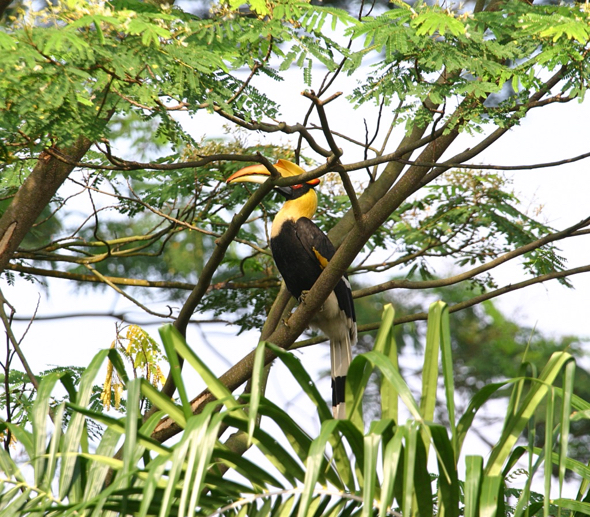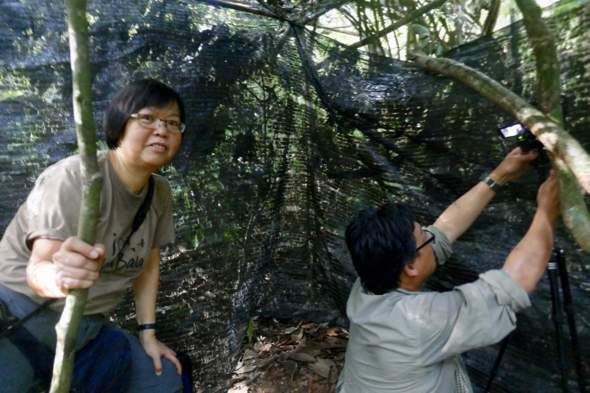
“This female Great Hornbill (Buceros bicornis) was observed on 2nd May 2018 at Khao Yai National Park (KYNP) feeding the chick at a nest in a tree by Bee Choo Strange and Dr. Pilai Poonswad with two other trainees during the International Hornbill Research Training Program. We were all inside a hide about 50m away.

“Hornbills usually nests in big trees especially those of family Dipterocarpacea. In this case, the female sealed itself inside the cavity of Dipterocarpus gracilis on 23rd Januart and came out on 9th April 2018. The chick was then sealed back inside the nest cavity. We observed the female feeding the chick 4 times and the male twice between 2-5pm. They feed the chick between 6 to 44 figs at any one time. We could hear the Great Hornbill every time one of them flew in to feed as well as it called to the chick when at the nest (see video below).
“This nest was first located in 2011 and the pair had been breeding successfully for the last 7 years. The nest cavity was repaired in 2013 and 2016 by staff of Thailand Hornbill Project (THP) after each breeding session. This was to ensure that the hornbills could reuse the nest. One of the problem was sunken floor such that soil had to be added to raise the floor. Should the nest floor is too low, the male would not be able to feed the female and chick and they would also not be able to defecate out of the nest opening. Enlarged nest opening also needed to be fixed. The staff of THP found 15 nests of the Great Hornbill in KYNP this year.
“Great Hornbill occurs in primary evergreen deciduous forests. It can be found at sea level but prefers hill forests further inland between 600 and 1,000 m elevation. The hornbill feeds in the crown of large trees, often a resident pair or a family group feed together.
“In Khao Yai NP mainly fruits are eaten and delivered to the nest, especially figs but also lipid-rich fruits such as those of the family Meliaceae (Aglaia, Dysoxylum and Chisocheton spp.) However,fruits of Polyalathia viridis (Annonaceae), Cinnamomum subavenum (Lauraceae) and Horsfieldia glaba (Myristicaceae) appear to be commonly consumed among the non-figs items.
“Flowers and buds are also taken, as well as many animals such as small mammals, birds and reptiles as well as large insects and other arthropods. When hunting, this hornbill hops along the branches and pokes into crevices and bark for prey, grabbing it with its huge bill and tossing it in the air for a better grip, before flying off to deliver it to the nest. A survey in Khao Yai NP found that the diet by weight during breeding was 57% figs, 29% other fruits and 14% animal food.
“Dr. Pilai Poonswad started observing hornbills in Khao Yai National Park in 1978 feeding at fig trees and was captivated by them. She started the Thailand Hornbill Project in 1979 with a few friends and this work is still ongoing. Many aspects of hornbills ecology had been studied such as habitat evaluation, population survey and monitoring, trapping of hornbills for radio and satellite tracking, measuring the hornbills, nest search. Nest trees study included nest cavity management, breeding ecology and phenology of food plants.
“For more information about hornbills and the work of Thailand Hornbill Project, you can go to this LINK.
“I would like to thank Mr. Gan Cheong Weei for the long-term loan of Sony HDR-CX150 Handycam to capture this video and also to Ms. Lily Sir for taking records of the food and feeding behaviour and Mr. Ittiphon Buathong who works with THP in Khao Yai NP. The videos are made possible by the hard work of the Dr. Pilai Poonswad and staff of Thailand Hornbill Project in KYNP especially Narong Jirawatkavi, Phitaya Chuailua and Kamol Plongmai.”
Bee Choo Strange
Singapore
16th May 2018
Reference: Poonswad, P., A.C. Kemp & M. Strange. 2013. Hornbills of the World. Draco Publishing and Hornbill Research Foundation. 212 pp.








